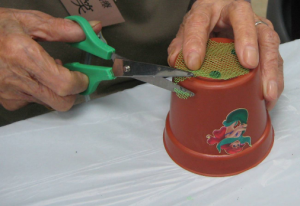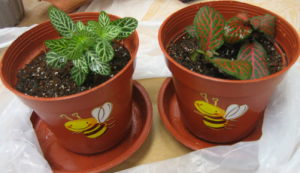Fung Yuen Yee, Connie
Horticultural Therapist Registered (AHTA)
Registered Social Work
President
HK Association of Therapeutic Horticulture
Population aging is a profound, pervasive and enduring storm sweeping across the world. Hong Kong is no exception. According to the HK statistics 2008, Hong Kong’s population has moved closer to seven-million and one out of eight Hong Kong people will be aged 65 or above. Department of Health and The Chinese University of Hong Kong conducted a study in 2005-2006 (Lam et al., 2008), and found the prevalence of dementia in adults over the age of 60 is 7.2%. It was also found that about 1 in 3 (32%) of the community-dwelling population aged 85 and above had dementia.
Dementia is a degenerative brain syndrome in which there is a gradual, insidious and relentless loss of cognitive functions. These cognitive deficits will further impair individuals’ social or occupational functioning and show a significant decline from previous level of functioning. Dementia can generally be classified into three stages: early, moderate, and severe. The early stage is characterized by the onset of deterioration in short term memory and cognitive abilities while in the severe stage, all intellectual functions breaks down and individuals with dementia will rely on caretakers to look after them in everyday lives. The most common form of dementia is Alzheimer’s disease. Yet, the causes of dementia are not yet known (Hong Kong Association of Alzheimer Disease, 2014).
Treatments for dementia include pharmaceutical and non-pharmaceutical methods. Horticultural therapy (HT) is one of the non-pharmaceutical treatments. HT has numerous advantages in treating dementia especially in fitting the needs of individuals suffering from different stages of dementia (Ebel, 1991).
“Smart Golden Age” HT project
“Smart Golden Age” HT project was held from Nov – Dec 2010 at 5 elderly centres in different districts of Hong Kong. Participants were community dwelling elderly who was suffering from mild to moderate dementia. Objectives of the groups were to provide cognitive training and facilitate social interaction among participants. Each group had 10 members and the program consisted of 5 sessions. Members propagated plants by cutting and division. Then they brought the propagated plants home and took care of them. They were required to bring them back to the centre for plant arrangement in the last 2 sessions.
Schedule of the groups
|
Date |
Theme |
Activities |
| 8/11 | New Hope I | Propagation: Cutting, Division |
| 15/11 | New Hope II | Propagation: Cutting, Division |
| 22/11 | Flower World | Flora Arrangement |
| 29/11 | New World I |
Plant Arrangement: Foliage Plant
(propagated in 1st session) |
| 6/12 | New World II |
Plant Arrangement: Succulent
(propagated in 2nd session) |
Application of HT with community dwelling elderly with dementia in Hong Kong
Hong Kong has a dense population and the living spaces for most of the people are quite small. As the program required the members to bring the plants home to take care of, it is important for the therapist to consider whether members have enough space at home for the plants. Otherwise, they have to place the plant at the center.
Elderly with mild to moderate dementia can participate in most of horticulture activities. Detailed task analysis is necessary and hence modifications can be made in accordance with members’ needs and abilities. So they can follow the instructions and complete the tasks accordingly.
Plant selection is important in achieving the therapeutic goals. The plants selected have to be safe and toxic free. Since most people live in an apartment and lack outdoor space, indoor plants with small pot sizes are preferable. In addition, the plants have to be grown easily, gripped with ease, and with elements of sensory stimulation and symbolic meanings. Plants that are commonly used are listed in the table below.
|
Plant |
Characteristics |
Sensory Stimulation |
Propagation |
Plant Arrangement |
Others |
| Chamaedorea elegans Mart | Easy growing, less pest… | Visual, tactile |
Division
Sowing |
√ | shade and humid environment |
|
Fittonia
verschaffeltii |
Easy growing, less pest… | Visual, tactile |
Division
Cutting |
√ | shade and humid environment |
| Draceana sanderiana |
Easy growing
Easy grip |
Visual, tactile | Cutting | √ | Chinese name means “Rich” |
| Kalanchoe Blossfeldiana |
Easy growing
Easy grip |
Visual, tactile | Cutting | √ | Chinese name means “longevity”, “happy family |
| Chlorophytum comosum | Easy growing | Visual, tactile | Division | √ | Have baby plant |
|
Succulent
|
Easy plant care | Visual, tactile |
Division
Cutting |
√ |
It is desirable for elderly with dementia to live in the community as long as they agreed. Community based services can provide enough supports for them and relieve the burden of their care givers. HT is a complementary therapy to incorporate into the services to enhance their quality of life.
Reference
American Horticultural Therapy Association, American Horticultural Therapy Association Definitions and Positions, retrieved on 4 Jan 2014 from http://ahta.org/horticultural-therapy
Census & Statistics Department, SAR., retrieved on 4 Jan 2014 from http://www.censtatd.gov.hk/home/index.jsp.
Ebel S. (1991). Designing Stage-specific Horticultural Therapy Interventions for patients with Alzheimer’s Disease. Journal of Therapeutic Horticulture, Vol. XI, 55-58.
Hong Kong Association of Alzheimer Disease retrieved on 4 Jan 2014 from http://www.hkada.org.hk/disease_02.php?lang=chi#.Usgf5nnxvIU
Jarrot, S., Kwack, H., & Relf, D. (2002). An observational assessment of a dementia-specific horticultural therapy program. Hortechnology, 12, 403-410.
Lam LC, Tam CW, Lui VW, Chan WC, et al. Prevalence of very mild and mild dementia in community dwelling Chinese older persons in Hong Kong. International Psychogeriatrics, 2008;20:135-48.
Suzanne E. Wells, 1997. Horticultural therapy and the older adult population. New York: Haworth Press



